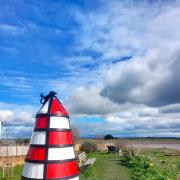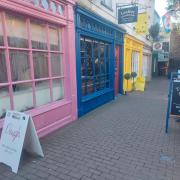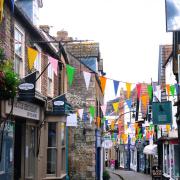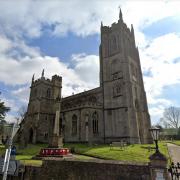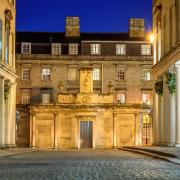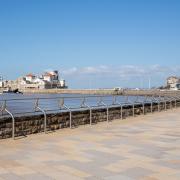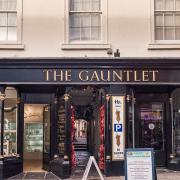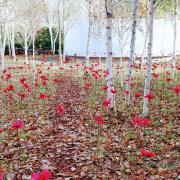Malcolm Rigby explores Wedmore, a village that for years has been bustling with retail activity and was host to a major historic event.
The principal village on the Isle of Wedmore, which is a ridge of high ground rising from the plains of the Levels, is a thriving and prosperous community that could easily lay claim to the title of the heart of rural Somerset. Wedmore village has charm, it has shops and it has history but, most importantly, it is a close-knit and spirited community.
You have to go back to 878 to find Wedmore's most significant claim to fame. King Alfred the Great gathered his warriors on the Somerset Levels before marching on to face the invading Danes. After a bloody battle at Edington in Wiltshire, Alfred took the vanquished Danish leader, Guthrum, to nearby Aller to be baptised and then on to his residency at Wedmore for 12 days of peace-making, feasting and further ceremonies. Nothing was signed but the agreement reached was known as the Peace of Wedmore and it severed the Danish hold on the south of England.
Since then Wedmore has been known as a centre for trade and commerce; a licence for a market in The Borough was granted in 1255 and shops were mentioned as early as the 1500s. There's been a tannery, a brickworks and a gasworks in the village, but primarily the chief business has been cattle and dairy produce.
Nowadays, although you would have to call it a commuter town, you certainly couldn't say that it sleeps during the day. Wedmore has more than 50 clubs and associations and over 30 shops, a phenomenal number for a village of this size. Perhaps a good example of all this community activity is the 'IT for the Terrified' scheme, which is run entirely by volunteers. Since its foundation in 1999 more than 2,000 people have made use of the project and learned the basics of computing skills.
Lifelong resident and local historian Hazel Hudson says: "When I was a child there were even more shops, but it's always been a centre for shopping and business. It's also very friendly; you walk down the street and there's always someone to talk to. Sometimes it takes you hours just to get home. And if you move in and you want to make friends there is every opportunity." As for visitors - they generally come to shop.
St Mary's Church
The chances are there was a Saxon church on the site when Alfred came to Wedmore to make peace with the Danes. The oldest part of the existing building, the base of the tower, is thought to be early 13th century, with extensions and rebuilds over the next few hundred years. Sometimes referred to as the Cathedral of the Moor, St Mary's is a large imposing church with a number of interesting features, not least the mural by the pulpit. This painting of St Christopher carrying the Christ child has been dated circa 1520 but was only rediscovered in 1880 after being whitewashed over by the Puritans.
Points of Interest
St Mary's Church has 101 corbels (stones that hold up the roof beams), which are decorated with a miscellany of faces.
Did You Know?
• The old English name of Wedmore means hunting moor
• The market cross was moved about 100 yards along The Borough in the 1830s to allow road widening
• In 1853 a cache of 200 silver coins from the Saxon age was discovered in the churchyard
• There used to be five windmills in the parish of Wedmore
• Wedmore locals created the Turnip Prize, which satirises the Turner Prize. Only bad art can be entered and the prize is a turnip on a rusty nail
Elmsett Hall
This striking building in the heart of the village has had many incarnations in more recent times. It's been a hotel, a night club, an antiques shop, a home for the elderly, a school and now it is flats. Originally it was built as a doctor's residence, housing a sequence of five Dr Glanvilles. One of these doctors, in the middle of the 1800s, decided that an elaborate tower was needed to add a little grandeur. The porch was also extended at this time so that the ladies could get out of their carriages without getting wet. The name originates from the fact that the first Dr Glanville came from the village of Elmsett in the south-east of England.
The Grape Press
This is a curious piece of 'public art' given to Wedmore in 1995 by the town of St Medard de Guzires to mark the 20th anniversary of the twinning association. The press is maintained by the Twinning Association and is part of the display that enabled the Wedmore in Bloom team to achieve a Gold Award last year. In the exchange of memorabilia, Wedmore gave the French town a traditional British red phone box, which is now located in the main square of St Medard, and is actually in use.
Porch House
This medieval building located on West End has had various later additions. In particular, it was thought that the porch was added during Tudor times in order to provide an extra bedroom. The house was inhabited by a Dr Westover, who kept a journal from 1680-1706, which is now held in the Somerset Records Office. The journal contains information about farming details but also about the doctor's patients, their illnesses (from toothache to mental instability) and their prescriptions. The barn next to Porch House, now a residence, was used by the doctor's inpatients - a kind of small private hospital or hospice.
Owen's Corner
This strange building was the John Lewis of its time, probably the biggest and most important shop in rural Somerset. It comprised a six-bedroom house, an elaborately decorated three-storey shop and a large tower behind. You could buy everything from groceries to linen and from ladies' fashions to china. There was a milliner, a toy department at Christmas, and even a small savings bank at the back. Once the ladies had shopped till they dropped they could have tea in the tower looking out towards Cheddar Gorge or Wells Cathedral. The edifice was built in the 1830s by the Tonkin family, owners of the Wedmore brickworks, who then sold it to the Owen family who can be seen in the picture, dated about 1900.
Market Cross
The villagers are rightly proud of their small but elegant market cross, which probably dates back to the 1300s. It has a lovely slender stem leading to a beautiful lantern head. This would have shown Christ on the cross, the nativity, a soldier and a priest, but the environment has taken its toll and little is visible now to the naked eye. There is a story that Judge Jeffreys came to Wedmore and hung some of the rebels on the village cross, but local historian Hazel Hudson says it is a complete fallacy: "We know exactly where Judge Jeffreys went and he never came to Wedmore. It may be possible that some of the rebels were hung and they brought little bits back and draped them over the cross but there's absolutely no proof, and you quite literally couldn't hang anybody on it."





